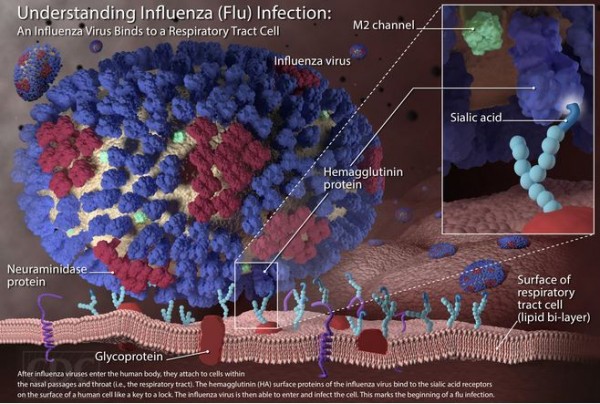Flu kills 21 American children; CDC warns of severe flu season in 2015
| Arthur Dominic Villasanta | | Jan 06, 2015 03:53 AM EST |
(Photo : CDC) Flu virus diagram from CDC
The Centers for Disease Control and Prevention (CDC) has reported the deaths of 21 children from the flu throughout the United States since the current flu season began Oct. 1.
CDC said early data suggests the current 2014-2015 flu season could be severe. It urges immediate vaccination for anyone still unvaccinated and recommends prompt treatment with antiviral drugs for people who develop flu and who are at high risk of complications.
Like Us on Facebook
The current flu outbreak officially became an epidemic the week of Dec. 20. By the week of Dec. 27, the severity of the epidemic slipped slightly. To define a flu epidemic, CDC uses a complex formula based on the rate of deaths from flu compared to previous years.
The current epidemic is, however, widespread in 43 states compared to 36 the week before, CDC said. CDC has confirmed 3,441 flu-related hospitalizations in 13 sample states since Oct. 1 based on lab tests. The actual number of flu victims is a lot higher across the U.S.
CDC identified the current flu strain as H3N2. This type is marked by often more severe flu illnesses, hospitalizations and deaths.
"It's too early to say for sure that this will be a severe flu season, but Americans should be prepared," said CDC director Tom Frieden, M.D., M.P.H.
"We can save lives with a three-pronged effort to fight the flu: vaccination, prompt treatment for people at high risk of complications, and preventive health measures, such as staying home when you're sick, to reduce flu spread."
Flu activity is currently low in the entire United States but is increasing in some areas of the country.
Influenza antiviral drugs such as Tamiflu (oseltamivir) and Relenza (zanamivir) can reduce severe complications such as hospitalization and potentially death for people at high risk of serious flu complications or are very sick.
Those at high risk from influenza include children younger than five years (especially those younger than two years); adults 65 years and older; pregnant women and people with certain chronic health conditions such as diabetes, asthma, heart or lung disease and kidney disease.
CDC recommends that treatment of high risk patients begin soon after symptoms develop without waiting for lab tests to confirm flu infection.
CDC asks people at high risk from the flu to check with their doctor or other health care professionals promptly if they get flu symptoms. Studies show that flu antiviral drugs work best for treatment when they are started in the first 48 hours after symptoms appear.
Flu symptoms can include fever, body aches, headache, cough, sore throat, runny or stuffy nose and fatigue.
CDC noted the H3N2 viruses were predominant during the 2012-2013, 2007-2008 and 2003-2004 seasons, the three seasons with the highest mortality levels over the past decade. All the epidemics in these years were characterized as "moderately severe."
More worrisome for CDC is the finding that about half of the H3N2 viruses it analyzed are viruses with antigenic or genetic changes (also called a "drift variant") that make them different from that season's vaccine virus. This means a vaccine's ability to protect against those viruses might be reduced
Vaccinated people, however, might have a milder illness if they do become infected. Drifted H3N2 viruses were first detected in March 2014.
CDC said at that time, a very small number of drift viruses were found in the thousands of specimens collected and tested.
"While the vaccine's ability to protect against drifted H3N2 viruses this season may be reduced, we are still strongly recommending vaccination," said Joseph Bresee, M.D., Chief of the Influenza Epidemiology and Prevention Branch at CDC.
"Vaccination has been found to provide some protection against drifted viruses in past seasons. Also, vaccination will offer protection against other flu viruses that may become more common later in the season."
©2015 Chinatopix All rights reserved. Do not reproduce without permission
EDITOR'S PICKS
-

Did the Trump administration just announce plans for a trade war with ‘hostile’ China and Russia?
-

US Senate passes Taiwan travel bill slammed by China
-

As Yan Sihong’s family grieves, here are other Chinese students who went missing abroad. Some have never been found
-

Beijing blasts Western critics who ‘smear China’ with the term sharp power
-

China Envoy Seeks to Defuse Tensions With U.S. as a Trade War Brews
-

Singapore's Deputy PM Provides Bitcoin Vote of Confidence Amid China's Blanket Bans
-

China warns investors over risks in overseas virtual currency trading
-

Chinese government most trustworthy: survey
-

Kashima Antlers On Course For Back-To-Back Titles
MOST POPULAR
LATEST NEWS
Zhou Yongkang: China's Former Security Chief Sentenced to Life in Prison

China's former Chief of the Ministry of Public Security, Zhou Yongkang, has been given a life sentence after he was found guilty of abusing his office, bribery and deliberately ... Full Article
TRENDING STORY

China Pork Prices Expected to Stabilize As The Supplies Recover

Elephone P9000 Smartphone is now on Sale on Amazon India

There's a Big Chance Cliffhangers Won't Still Be Resolved When Grey's Anatomy Season 13 Returns

Supreme Court Ruled on Samsung vs Apple Dispute for Patent Infringement

Microsoft Surface Pro 5 Rumors and Release Date: What is the Latest?











